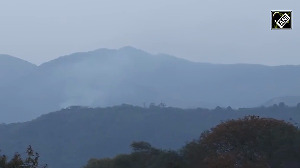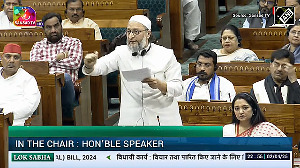 The Cabinet on Thursday decided to allow Reliance Industries to almost double the price of natural gas from April provided the firm gave a bank guarantee to cover its liability if gas-hoarding charges are proved.
The Cabinet on Thursday decided to allow Reliance Industries to almost double the price of natural gas from April provided the firm gave a bank guarantee to cover its liability if gas-hoarding charges are proved.
The bank guarantee, which will be equivalent to the incremental revenue that RIL will get from the new gas price, will be encashed if it is proved that the company hoarded gas or deliberately suppressed production at the main Dhirubhai-1 and 3 (D1&D3) fields in the eastern offshore KG-D6 block since 2010-11, sources said.
Prodded by the Finance ministry, the Oil ministry had initially proposed to deny the new gas prices that will kick in from next fiscal till such time that RIL either made up for the shortfall in output during past three fiscals, or it is proved that the company was not responsible for production falling below targets.
The issue had held up notification of the new gas pricing formula that will be applicable to all producers - public and private - and all forms of gas - conventional and unconventional forms like coal-bed methane and shale gas.
As a way out, it was proposed that RIL and its partners BP plc of UK and Canada's Niko Resources be asked to give bank guarantees for the incremental revenue they will get till the hoarding issue is resolved through arbitration and validation by independent international experts.
The government in June approved the Rangarajan formula for pricing of all domestically produced natural gas at an average of global gas hub rates and price at which India imports LNG (gas in liquid form).
The rate in April 2014, when the new pricing is to be implemented, will be about $8.4 per million British thermal units as against the current $4.2.
The Finance Ministry, however, wanted certain changes in the approved formula by excluding liquefied natural gas (LNG) purchases from the spot market, which it said was highly volatile. After excluding spot purchases, the new gas price should be $8.1.
Prices of natural gas, which is an input to manufacturing fertiliser and electricity generation, will be revised every quarter based on the average of the past four quarters, with a gap of one quarter.
In the run up to the Cabinet decision, the Finance Ministry sought to know if government position on reasons for fall in gas output at KG-D6 will be diluted by accepting bank guarantee.
In the arbitration, RIL is countering the government's stand that non-drilling of committed wells led to an 80 per cent fall in output by citing geological complexities and lower than anticipated reserves. The arbitration may linger for an indefinite period, the Finance Ministry feels.
It was of the view that the bank guarantee in that case may run into about $9 billion which needs to be monitored. It also wanted to know the proposed course of action in case RIL does not comply with bank guarantees.
Prodded by the Finance Ministry, the Oil Ministry had initially proposed to deny the new gas price until RIL either made up for the shortfall in output during past three financial years or it was proved that the company was not responsible for failing to meet production targets.
The issue had held up notification of the new gas pricing formula. As a way out, it was proposed that RIL and its partners BP plc of UK and Canada's Niko Resources be asked to give bank guarantees for the incremental revenue they would get until the issue is resolved through arbitration and validation by independent international experts.
The government approved the Rangarajan formula in June. The Finance Ministry wanted to change the approved formula by excluding the price of spot LNG purchases, which it said was highly volatile. This would have reduced the gas price to $8.1.
Moily said the CCEA today decided that "no change needs to be made in the early decision of CCEA on including spot prices in computation of gas price. Also, no cap or floor on gas price is required to be stipulated."
In the run-up to the Cabinet decision, the Finance Ministry had sought to know if the government's position on the reasons for the fall in gas output at KG-D6 would be diluted by accepting the bank guarantees.
Also, it felt the bank guarantees would run into $9 billion during the duration of the arbitration, but Rae said the oil ministry believes the bank guarantee, which is to be given on a quarterly basis, would not accumulate to such an amount.
At the instance of the Finance Ministry, the Oil Ministry had in August proposed to the Cabinet that RIL be forced to sell gas from the D1&D3 fields at the current rate until it is proved the 80 per cent fall in output was due to natural reasons or it the shortfall in production is made up.
This would have meant pronouncing RIL guilty even before trial, an official said. The veracity of allegations that RIL hoarded gas in anticipation of a price hike can be established by arbitration or a third-party expert, a process that can take 1-2 years.
The official said: "If we forced RIL to sell gas at $4.2 and at a later date it was established that output had fallen due to geological reasons and there was no hoarding, then who would make good the difference between $4.2 and the price they are actually eligible from April 1, 2014?"
The official added that the government cannot ask consumers to pay a higher price for gas consumed in the period taken to decide on the hoarding charge. The government, he said, could have charged customers the higher price from April 1 and paid RIL the lower rate while keeping the difference in an escrow account until the issue was sorted out. However, the production sharing contract does not provide for escrow accounts.
The bank guarantee will be calculated quarterly as the gas price will change every three months, based on average international hub prices and the rate at which LNG is imported to India.
The bank guarantee will be about $90 million in the first quarter of fiscal 2014-15, considering an anticipated output of less than 8 million metric standard cubic metres per day (mmscmd) from D1&D3, after netting the excess royalty that RIL will pay at the higher price.
A lower gas price would have been the second penalty imposed by the Oil Ministry for RIL falling short of stated production targets. It had already levied a $1.8 billion penalty for the output drop, an issue that is in arbitration.
Gas production from the D1&D3 fields fell to 8.7 mmscmd this month from a peak of 54 mmscmd in March 2010. Production has been below target since the latter half of fiscal 2010-11 and should currently have been 80 mmscmd, as per the 2006 investment plan.
Output from the MA oil and gas field in the KG-D6 block, too, has fallen over 62 per cent. However, the ministry and the Directorate General of Hydrocarbons, the oil regulator, agreed with RIL's reasoning that geological complexity was responsible for the drop and approved the higher price for the MA field's output.










 © 2025
© 2025